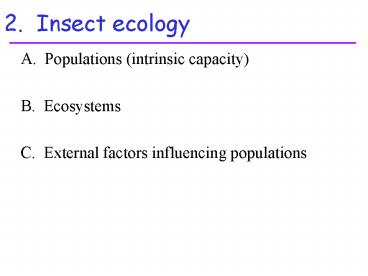2' Insect ecology PowerPoint PPT Presentation
1 / 26
Title: 2' Insect ecology
1
2. Insect ecology
- A. Populations (intrinsic capacity)
- B. Ecosystems
- C. External factors influencing populations
2
Populations influenced by
Ch. 5
Intrinsic capacity Survival Developmental
time Fecundity Environmental influences Abiotic
factors (Temperature, water) Biotic factors
(Food, enemies, symbionts) Density (sex
ratios) Dispersion Events (cycles, circumstances)
3
A. Populations (intrinsic capacity)
Survival (deaths over time)
Repro- ductive rate (births over time)
Generation Developmental rate (time)
4
Survival, development fecundity
hatch (eclosion)
larva
oviposition
pupa
adult
egg
a
b
Survival (lx) (proportion)
death
c
Fecundity (mx) (egg/female/day)
Development
p. 185
Time
5
Life-table
(see also p. 186)
Day (x) 0 1 2 3
4 5 6 7
Survival (lx) 1.00 .95 .50 .45
.40 .30 .10 0
eggs/f/d (mx) 0 0 0 0
6 4 2 0
6
Base rates x 0 1 2 3
4 5 6 lx 1.0 .95 .50
.45 .40 .30 .10 mx 0 0
0 0 6 4 2 90
morality on day 4 of first generation x 0
1 2 3 4 5
6 lx 1.0 .95 .50 .45 .04 .03
.01 mx 0 0 0 0 6
4 2 Half developmental rate x
0 2 4 6 8 10
12 lx 1.0 .95 .50 .45 .40
.30 .10 mx 0 0 0 0
6 4 2
GRR __ eggs Ro __ T ____ days 21d pop. ___
GRR __ eggs Ro ___ T _____ days 21 d pop.
___
GRR __ eggs Ro ___ T _____ days 21 d pop.
___
7
Environmental Influences Abiotic
factors Biotic factors Events
Temperature Water Chemicals Place
Survival DevelopmentFecundity
Food Predators Symbionts
Cycles (seasonal, daily), accidents
8
Ecosystems Definitions on p.
176
Natural
Managed
Organization of ecosystems Natural human
selection Food chains Situation events
9
- Natural selection
- Pre-existing variability
- Heritability
- Increased fitness
- Examples
- Sweetness of fruit
- High quantity of seed
- Resistance to environmental stresses
- Etc.
10
- of domesticated plants animals
- Availability of types
- True to type
- Increased value
Human selection
- Natural selection
- Variability of traits
- Heritability of traits
- Increased fitness
11
Managed ecosystem
Natural selection reproducing components
Fitness Human selection non-reproducing
Value
12
Pest-- Organism which decreases fitness or
value Pest management-- Actions which
limit a pests impact
13
Food Chain
Carnivore (Tertiary consumer)
Carnivore (Secondary consumer)
Eating live veggies or meat
Herbivore (Primary consumer)
Death and use of dead
resources
Plant (Producer)
Detritivore (Decomposer)
14
Energy Flow--trophic levels
Secondary consumers
Decomposers
Primary consumers
Biomass
Energy
Producers
15
Agroecosystem
Secondary consumers
Human users
Primary consumers
Decomposers
Biomass
Producers
16
Secondary consumers
Egg Nymph Adult
Results of predators
Herbivore survival (lx)
Time
17
without predators
Herbivore density
with predators
Time
Density, outbreak, regulation, extinction
18
Population regulation
Herbivore outbreak
Herbivore extinction
Time
19
Direct density dependence pp. 204-207
of herbivores killed
Herbivore density
...functional numerical responses
20
Functional response
herbivores eaten per predator
Herbivore density
- Search efficiency
- Feeding time per unit
- Satiation
21
Numerical response
Predator offspring (generation T1)
Herbivore density (Predator generation T)
- More food increases predators
- survival
- developmental rate
- reproduction
22
Delayed density dependence
5
4
3
6
of herbivores killed
7
2
1
Herbivore density
23
Degree-days
pp. 198-203
2 pm
Temp.
Developmental rate
7 am
7 pm
7 am
Temperature
Time
24
Degree-days
Accumulated Degree-days
Pre Hatch Pupation Adult eclosion
Codling moth Pre egg laying 58 dd Hatch 158
dd Pupation 471 dd Adult eclosion 431 dd
Biofix--trap first adults
25
- Seasons
- Fire
- Flood
- Events
- Ag practices
- Selection of land
- Cultivar selection
- Fertilization, watering, weeding
- Harvest
26
Does Agriculture cause pest outbreaks?
- Plowing, Synchrony loss ofharvesting
continuity of hosts - Watering, Optimization offertilizing abiotic
factors - Plowing, Simplificationplanting, weeding,pest
control,economy of scale
More food fewer predators
PESTS

